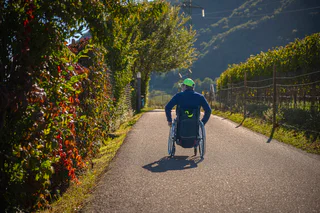
1/3
Accessible Hiking Trail at the Lake
St. Josef am See/S. Giuseppe al Lago, Kaltern an der Weinstraße/Caldaro sulla Strada del Vino, Alto Adige Wine Road
Załóż buty turystyczne i odkrywaj krajobrazy wzdłuż Południowotyrolskiej Drogi Winnej. Te wskazówki dotyczące wędrówek poprowadzą Cię krętymi ścieżkami, przez malownicze winnice i urocze wioski, aż do wietrznych panoramicznych miejsc. Od spokojnych spacerów po wymagające wycieczki - dosłownie każdy znajdzie tu coś dla siebie. Idealne połączenie obcowania z naturą i kulturą przy jednoczesnym delektowaniu się lokalnymi winami i ciepłą gościnnością charakteryzuje Południowotyrolski Szlak Winny jako region wędrówek dla koneserów.

1/3
St. Josef am See/S. Giuseppe al Lago, Kaltern an der Weinstraße/Caldaro sulla Strada del Vino, Alto Adige Wine Road

Pinzano/Pinzon, Montan/Montagna, Alto Adige Wine Road

1/3
Monticolo/Montiggl, Kaltern an der Weinstraße/Caldaro sulla Strada del Vino, Alto Adige Wine Road

Ora/Auer, Auer/Ora, Alto Adige Wine Road

Sella/Söll, Tramin an der Weinstraße/Termeno sulla Strada del Vino, Alto Adige Wine Road

1/4
Oberplanitzing/Pianizza di Sopra, Kaltern an der Weinstraße/Caldaro sulla Strada del Vino, Alto Adige Wine Road

1/14
Laghetti/Laag, Neumarkt/Egna, Alto Adige Wine Road

1/5
Salorno/Salurn, Alto Adige Wine Road

1/6
Mazzon/Mazon, Neumarkt/Egna, Alto Adige Wine Road

1/4
S. Michele/St. Michael - Appiano/Eppan, Eppan an der Weinstaße/Appiano sulla Strada del Vino, Alto Adige Wine Road

Laghetti/Laag, Neumarkt/Egna, Alto Adige Wine Road

1/4
Mazzon/Mazon, Neumarkt/Egna, Alto Adige Wine Road

1/7
Gleno/Glen, Montan/Montagna, Alto Adige Wine Road

1/2
Obereggen/Obereggen, Deutschnofen/Nova Ponente, Alto Adige Wine Road

1/7
Laghetti/Laag, Neumarkt/Egna, Alto Adige Wine Road

Terlano/Terlan, Terlan/Terlano, Alto Adige Wine Road

1/3
S. Michele/St. Michael - Appiano/Eppan, Eppan an der Weinstaße/Appiano sulla Strada del Vino, Alto Adige Wine Road

1/7
Caldaro Paese/Kaltern Dorf, Kaltern an der Weinstraße/Caldaro sulla Strada del Vino, Alto Adige Wine Road

1/3
Cortaccia s.S.d.V./Kurtatsch, Kurtatsch an der Weinstraße/Cortaccia sulla Strada del Vino, Alto Adige Wine Road

Laag/Laghetti, Neumarkt/Egna, Alto Adige Wine Road

Vilpiano/Vilpian, Terlan/Terlano, Alto Adige Wine Road

1/11
Andriano/Andrian, Andrian/Andriano, Alto Adige Wine Road

Magrè s.S.d.V./Margreid a.d.W., Margreid an der Weinstraße/Magrè sulla Strada del Vino, Alto Adige Wine Road

Sella/Söll, Tramin an der Weinstraße/Termeno sulla Strada del Vino, Alto Adige Wine Road

1/3
S. Michele/St. Michael - Appiano/Eppan, Eppan an der Weinstaße/Appiano sulla Strada del Vino, Alto Adige Wine Road

1/4
Sella/Söll, Tramin an der Weinstraße/Termeno sulla Strada del Vino, Alto Adige Wine Road

1/6
Missiano/Missian, Eppan an der Weinstaße/Appiano sulla Strada del Vino, Alto Adige Wine Road

1/8
Pinzano/Pinzon, Montan/Montagna, Alto Adige Wine Road

1/5
Terlano/Terlan, Terlan/Terlano, Alto Adige Wine Road

Ronchi/Rungg - Termeno/Tramin, Tramin an der Weinstraße/Termeno sulla Strada del Vino, Alto Adige Wine Road